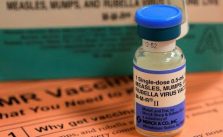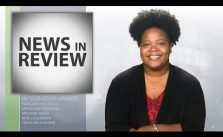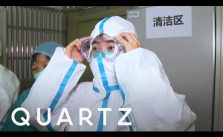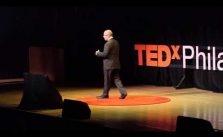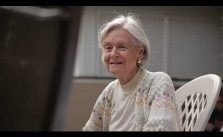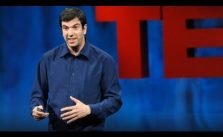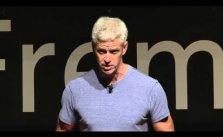Ladies and gentlemen the Deputy Secretary of the U.S. Department of Health and Human Services, Eric Hargan. Good afternoon, everyone, and thank you all or joining us here today. Today is a great day to celebrate the accomplishments of our department of the past year, and I hope you all look forward to hearing Secretary Azar run through some of our high notes, of which there are many.
Before he does so, I wanted to lay out some of the many external recognitions that our Department has received for our work over the past year. Which as I said there are indeed many.
First, as many of you know, HHS was ranked the best cabinet department at which to work in 2019, for the third year in a row that we have received this award. (Applause) Our employee engagement score ticked up slightly, while overall participation used to determine in the survey used to determine this, the Federal Employee Viewpoint Survey, rose dramatically, from 57 percent to 72 percent.
Thank you to those of you who responded to my many all staff emails encouraging you to take the survey. We’ve distributed that data throughout the department for use to improve HHS as a workplace even more.
Notably, one tool that NIH developed to analyze FEVS results much more rapidly is now in use across HHS and has now been recommended across the government by OPM, as part of the President’s Management Agenda, to improve use of employee feedback.
Not only are we helping ourselves, we are helping the entire government. Also on our human resources front, I am happy to say that over the last year there has been a 73 day reduction in the average hiring time. Now as to the fact that we could bring down the average hiring process by 73 days shows we had a lot of room for improvement, and we are still working on this.
Keep tuned in on this. Large numbers of HHS employees also received individual awards to recognize their accomplishments in various fields. This included 25 winners of OMB’s Gears of Government Awards, which recognize individuals and teams that have delivered key outcomes in terms of mission results, customer service, and accountable stewardship.
And of those 25, 3 were awarded at the highest level possible, the Presidential Level. We are a very big department, but having a $1.3 trillion budget doesn’t make it any easier to win management awards, but these award winners were and I wanted to let you know it took place in a ceremony at OMB which isn’t necessarily the largest ability to get the message out.
For those of us at HHS I wanted to recognize them.
1. Dr. Kathleen Uhl from FDA who pioneered the transformation of generic drug regulation, improving availability and acceptance of generics that have the same high quality as brand-name counterparts. In fiscal year 2017, FDA approved 971 generic drug applications of which 19 percent were for first generics, paving the way to make these products more affordable for patients and we have that result already.
2. Comprised of Kenneth Kraft, Dustin Litwiler, Jess Weisz, Cassandra Newsome, and Roman Kulbashnya, Team Inspector General led an interdisciplinary and interagency effort, leveraging existing IT resources and combining disparate agency data, to identify and exclude healthcare providers convicted of opioid abuse, sexual assault, rape, and manslaughter from participating in federal healthcare programs.
This initiative yielded hundreds of measurable exclusion referrals that directly advanced the HHS Office of Inspector General’s mission to protect taxpayer-funded healthcare programs like Medicare and vulnerable beneficiaries from abuse.
3. Last but not least, Dr. Emily Haas was recognized for her research work on mine safety. As you may know the mission of the Mining Program at the National Institute for Occupational Safety and Health, or NIOSH, which is part of the CDC, is to create these outcomes through relevant research and impactful solutions. Dr. Emily Haas of NIOSH made major advancements in its mission by improving how to measure safety culture in the mining industry and how to develop and implement industry-wide strategies to improve workers’ safety.
We also had a winner of a Sammie, a Service to America Medal, which are known as the Oscars of Government Service. Secretary Azar personally presented the award, for accomplishment in Science and Environment, to Dr. Daniel Jernigan of the CDC. It’s also worth noting that we had a finalist for the Sammies, Dr. W. Marston Linehan, from the National Cancer Institute he was a finalist in the same category as Dr. Jernigan.
There’s nothing like a little friendly competition from your coworkers! Congratulations to both of them. Finally, in recognition of all the hard work that staff from across HHS put into the launch of President Trump’s historic kidney health initiative this past year, the American Society of Nephrology awarded their President’s Medal to eleven HHS staff, including from the CTO’s office, CMS, OASH, and FDA and even the immediate Office of the Secretary.
In other news we are also the #1 Department for regulatory reform for now two years in a row, leading to relief for health providers and a greater ability to dedicate resources to care rather than paperwork, where it is not necessary. Thank you to everyone who has been a part of this effort. Also I am happy to announce that we have graduated five out of the ten ReImagine initiatives into permanent homes at HHS, they are:
1. Bringing common sense to food safety at FDA.
2. Aim for independence in Human Services.
3. Maximize talent for HR.
4. Accelerating Clinical Innovation.
5. Optimizing Regional Performance.
That has been a lot of work. Now, without further ado, I want to introduce Secretary Azar. But, first, to set things up for his speech, we’re going to show you a new video we’ve developed that you’ll see being used across the department in the near future which shows the important contributions all of you make to fulfilling our mission to improve the health and well-being of all Americans. Thank you again for your hard work over the last year which is increasingly being recognized across the government and enjoy the video and the speech.
Thank you. The Department of Health and Human Services is many things: We are more than 80,000 employees, in more than 2,000 locations across the country and around the world. We are some of the world’s finest scientists, physicians, researchers, and public servants.
We are a big, busy, dedicated team. Yet all of us share one thing in common: our mission, to protect and enhance the health and well-being of every American. Our mission means reforming, strengthening, and modernizing America’s healthcare system, by keeping the patient at the center.
Our mission means protecting the health of Americans where they live, work, and play, from infectious disease, from addiction, and so many other threats. Our mission means strengthening the economic and social-well-being of all Americans, of every age.
Our mission means fostering sound, sustained advances in the sciences to help Americans live longer, healthier lives. With energy, dedication and focus, we, the men and women of HHS are committed to fulfilling our mission of serving the American people.
Ladies and gentlemen the Secretary of the U.S. Department of Health and Human Services, Alex Azar. Hey everyone. Hello and thank you very much. Thank you. Please please. Yes, it is still me. Although I am waiting the results for the Med page Twitter survey to see if I am allowed to keep it or not. We’ll see how that shakes out. I haven’t gotten the results yet.
But thank you all for joining us here today in the Great Hall and thank you for those that are joining us virtually. I hope everybody enjoyed that new video. I’m glad to have members of our HHS family watching via livestream today not only from across America, but really from around the world.
That’s especially the case because our department’s global work has been in the news quite recently, as all of you are well aware. Since December, when the novel coronavirus outbreak in China began to threaten to spread to American soil, there have been men and women at CDC, NIH, and elsewhere hard at work to respond to the outbreak and protect Americans.
The commitment to keeping Americans safe runs straight to the top. I have been speaking with the President regularly on the issue, and through the novel coronavirus task force, we’ve been working closely with other departments and the National Security Council.
There are still many unanswered questions about the virus, which your colleagues are working hard to resolve. But everyone here should be proud to be part of a department, and a healthcare system, that is capable of mounting the rapid and science-driven response that we’ve seen.
Within just weeks of the outbreak’s beginning, CDC scientists were able to develop a test that is now being distributed to state and local health departments so they can confirm cases of the virus here in the United States. NIH, ASPR, FDA, and others are hard at work on possible therapeutics and vaccines.
There is much work ahead of us, but for now, I want to give a round of applause to all the members of our HHS team, and our partners across other federal government and at the state and local level. Let’s thank them for their hard work so far.
[applause] Today is a chance for us to celebrate the results that you, as public servants, have delivered over the past year and to talk briefly about what we can accomplish together this year and over the next five years. The accomplishments I’m going to run through today can’t be comprehensive we’d be here all day if I tried to go through every major achievement of the department over the past year.
We have a little more room to be comprehensive in the annual report that the department published today, so I encourage you to check out that report and learn more about the amazing work your colleagues have done over the past year. Like last year, the annual report is organized into our five strategic goals as a department, which are important guides for our long-term planning.
I’ve also talked however about our work as falling under three key themes: facilitating patient-centered markets in healthcare, the second is protecting life and lives, and the third is promoting independence. All of our policy work from each and every payment rule out of CMS; to the work that the CDC does around the world; to the partnerships ACF builds with state and local governments all of it falls within one of those three themes.
I’ll start with what it looks like to use markets to put patients at the center and deliver more affordable healthcare and better health for every American. President Trump has an exciting vision for healthcare, which we’ve articulated and worked toward this past year and for frankly the last three years: a system with affordable, personalized care, a system that puts you in control, provides peace of mind, and treats you like a human being, and not like a number.
Undergirding this vision is a promise from the President: He’ll protect what works in our system and make it better. Some steps we took to deliver on that vision over the past year are going to be truly dramatic improvements to the patient experience.
We finalized a requirement that hospitals have to disclose to patients, in an easily accessible way, the prices that they want to charge. We proposed to require that insurers provide their pricing information, too, so patients know what they’ll owe for a procedure before they have to get the procedure and long before they get the bill in the mail. Imagine that, how can you do that.
We put out our draft rule on interoperability, which will require that patients finally be given access to their own healthcare data at no cost to them. Fixing these problems will be a fundamental shift toward putting the patient at the center of our healthcare system.
Every little step counts, and we’ve already seen many changes have an effect on the provider and patient experience. I’ll give you one example from CMS’s Patients over Paperwork initiative, which is projected to save 42 million hours of providers’ time through 2021.
Last year, we heard from an organ transplant surgeon at Johns Hopkins in Baltimore that he liked to set up his patients with their meds, in an organized pillbox, and talk them through the medications, before they were discharged from the hospital following a transplant.
But, due to a Medicare policy, he couldn’t set them up with their immunosuppressant medications. Those had to be shipped to the patient’s home address or home pharmacy. So we looked into this, and made a change so that the patient can receive his or her meds before heading home from the hospital.
Here’s what one of the surgeon’s patients said about the change: I don’t know how I could have handled going to a pharmacy and filling all of these medications that I need to take this evening after all I’ve been through. Thank you so much for making sure I have my medications this is one less thing to worry about.
(Applause) That is the kind of result you can produce through hard work to put the patient at the center. And it’s just the beginning of building a more patient-centered system including our sweeping efforts, through HRSA and CMS, to increase the number of lifesaving organ transplants.
I’d be remiss if I didn’t note that, next year, when we’ve finalized our proposed changes to the Stark Law and the Anti-Kickback statute, that Hopkins’ doctor may be able to make that pillbox a smart pillbox, and provide a home health aide to go home with the patient, talking them through their medicines as needed.
Providing these convenient, tailored benefits to promote health is also what we’re trying to do with new flexibilities in Medicare Advantage, which now allows plans to provide more supplemental benefits, such as home-delivered meals, transportation, and home modifications.
You may or may not be aware of that change, but if you watch a lot of cable news which none of us should do of course, unless it’s to see Dr. Fauci talk about coronavirus you may have seen frequent commercials talking about how Medicare beneficiaries can call a 1-800 number to inquire about whether they’re eligible for these new benefits.
I should note, these ads aren’t just on cable news they also drive me a bit crazy when I just want to get back to binge-watching the latest Bravo show. One particular ad looks a bit like something out of the 1990s, with red, white, and blue graphics, and, to complete the picture, there’s an NFL star from the 1960s involved.
On its surface, this doesn’t look or sound like the future of healthcare but it represents important work done here at the department, placing patients at the center and providing them with a tailored set of benefits that will keep them healthy and keep their costs affordable.
We’ve delivered significant results on affordability over the past year: Average Medicare Advantage premiums are now the lowest in 13 years, while Part D premiums are the lowest in seven years. We saw 1,200 MA plan options added from 2018 to 2019.
These are real savings real options for our seniors let’s thank everyone at CMS who worked hard to make that happen. Thank you. [applause] And, according to the National Health Expenditure data, in 2018, retail prescription drug prices dropped for the first time in over four decades.
What’s driving that historic trend? In part, it’s the amazing success we have seen at FDA for several years now: Fiscal Year 2019 saw a third straight year of record generic drug approvals, a historically high number of novel drug approvals, and a record number of biosimilars approved.
FDA also laid out the first-ever pathway for the safe importation of prescription drugs to lower drug costs, which we look forward to implementing this year. Let’s offer a special thank you to the men and women of the FDA for the results they’ve delivered over the past several years.
[applause] As all of you know, HHS is also proud to deliver patient-centered care directly, through the Indian Health Service. I’ve been immensely proud to see IHS’s commitment over the past year to establishing a new culture of quality, including through the formal establishment of the first-ever IHS Office of Quality.
Any major hospital system has a quality office like that, and the patients we serve in Indian Country deserve the same. We’ve seen some results already, from the award of a new contract for an adverse events reporting and tracking system to steps forward on CMS certification.
As of the end of 2019, 96 percent of all IHS hospitals and 97 percent of all eligible ambulatory care facilities have CMS certification. This work has been supported by the significant boosts in funding for IHS that the leadership of this department helped secure over the past year.
Tribal healthcare is also a key piece of our initiative to end the HIV epidemic in America, which is a part of the second theme I want to touch on: protecting life and lives. President Trump announced our HIV initiative just around this time last year, in his 2019 State of the Union address.
Since then, Congress fully funded the President’s budget request for the initiative; we’ve secured a donation of prevention medication for 200,000 uninsured Americans; we’ve made planning grants to the 57 jurisdictions that account for half of the new HIV infections in America; and we’ve already started implementation in four jurisdictions.
That is an incredible set of results in one year, so I’d like to applaud everyone, across the department, who has played a role in launching that initiative with such speed. [applause] That initiative will also build on the successful programs we already run for HIV, such as HRSA’s Ryan White HIV/AIDS Program, which hit another record this past year, get this reaching an amazing 87 percent of patients on viral suppression.
HRSA has also played a role in the success we’ve begun to see in combating our country’s crisis of opioid addiction and overdose. At long last, in 2018, we began to see results on the most important number of all.
For the first time in more than two decades, the number of drug overdose deaths declined by 4 percent, helping American life expectancy overall rise for the first time in four years.
We’re winning because our strategy is working. The number of Americans receiving medication assisted treatment has increased by 41 percent from 2016 until now. Since January 2017, the estimated total amount of opioids prescribed in America declined by 32 percent.
These are real victories but we’re not going to let up in our focus on substance abuse and mental health. We know there are concerning trends, such as a rising number of deaths from methamphetamine overdoses. This past year, we’ve already taken action to respond, securing flexibility for states to use SAMHSA’s State Opioid Response program to deal with addiction to stimulants like meth, too.
We’re also continuing to ensure that Americans have access to appropriate pain treatment. Toward that end, today, our Agency for Healthcare Research and Quality released a new evidence-based tool to help primary care providers better manage patients who need long-term opioid therapy.
I should note, not every division gets to announce something in the State of the Department address but 2019 was AHRQ’s 20th anniversary, so, happy birthday, AHRQ! [applause] We’ve been vigilant against addiction on all fronts.
In 2019, NIH, FDA, and CDC data showed that the number of American youth using e-cigarettes rose dramatically again. We laid out a path for action, effective this week, that prioritizes enforcement against the products most popular with our kids.
This is just part of the Trump Administration’s overall commitment to protecting a new generation from nicotine addiction and to continuing reductions in smoking rates. You saw that commitment reinforced recently with the release of the first report the Surgeon General has issued in almost 30 years that focuses specifically on how to quit smoking, and the benefits it delivers at any age.
Another vital way to protect the health of our kids is ensuring that parents are working with their doctors to get kids their recommended vaccinations. Sadly, this past year saw our country’s largest measles outbreak since 1992, threatening our country’s measles elimination status. CDC led an aggressive response, in cooperation with state and local health departments.
We took this troubling development as an opportunity to go on the offense, launching an unprecedented media campaign of HHS leaders promoting the importance of vaccination. Our work to protect life and lives goes beyond healthcare, too.
In 2019, FDA took major new strides to keep America’s food supply safe. As part of implementing the Food Safety Modernization Act, the agency began the first-ever routine inspections of large farms for produce safety, working under cooperative agreements with state partners to conduct more than a thousand large farm inspections. We’ve protected Americans in times of emergency, too.
Last year, ASPR led the federal government’s public health and medical response to seven hurricanes, two earthquakes, and the California wildfires. More than 2,120 federal disaster responders were deployed by ASPR to help lead the response, along with 214 tons of medical equipment and supplies.
That included more than 1,400 officers from the U S. Public Health Service Commissioned Corps, who deployed for nearly 32 disaster events, planned events, and community health missions. I’m proud to say that the Commissioned Corps is increasingly ready to respond to 21st century health challenges, and is in fantastic shape today.
That is literally the case the Commissioned Corps is now the second most physically fit service as measured by body mass index. Second only to the Marines! [applause] I’d like to personally thank all HHS personnel who contributed to this emergency work over the past year.
Let’s give them a round of applause. [applause] Our work to protect life and lives extends well beyond our shores, and I had a chance to see that in person this past year. Combating the ongoing Ebola outbreak in the eastern Democratic Republic of the Congo has been one of the Trump Administration’s top global health priorities since the outbreak began in 2018.
This past fall, I underscored that commitment when we traveled to the DRC, Uganda, and Rwanda with our head of global affairs, Garrett Grigsby; Director Redfield of the CDC, Dr. Fauci of NIH, Admiral Ziemer of USAID, and officials from the National Security Council. I cannot overstate what a challenging situation we face in the Congo.
We have a large-scale outbreak of Ebola in a warzone one of the most remote and least developed places on the face of the planet. One key reason that the outbreak hasn’t spun out of control is that we have tools today that we did not have during the 2014 West Africa outbreak, and a key reason we have those tools is the dedication of men and women across HHS at NIH, FDA, CDC, the Commissioned Corps, BARDA, and elsewhere.
It was incredibly moving to see firsthand how these tools have helped. We had one young boy, about 8 or 9 years old, proudly show us the certificate he would bring back to his family, certifying him as Ebola-free, after he received one of the drugs that’s part of the clinical trial that NIH is running, a four arm clinical trial being run, right in the middle of one of the most active war zones in the world.
Many of the healthcare workers we’d met had received what was then the investigational vaccine to protect themselves from infection. As of December, that vaccine is now an FDA-approved product. That isn’t the only international humanitarian crisis that HHS had to handle this year.
I also had the chance to see officers of the U.S. Public Health Service Commissioned Corps at work on the USNS Comfort, the American hospital ship that was deployed this past year to respond to the humanitarian crisis in Latin America, which was caused by the failed Maduro dictatorship in Venezuela.
The Commissioned Corps also played a key role in responding to the humanitarian crisis we saw at our own southern border, which resulted in an unprecedented number of unaccompanied alien children entering ACF care nearly 70,000 in FY 2019.
ACF’s Office of Refugee Resettlement worked to maintain consistent, high-quality care and safely unify children with sponsors, while we secured emergency funding from Congress and found other flexibilities to help care for these children.
ACF was able to expand our capacity to care for this record number of children while laying a foundation for a more flexible, sustainable system to handle such influxes in the future. Much of this work at ACF relies on our faith-based and community partners, and we took significant steps this past year to remove unfair burdens that had been imposed on faith-based partners.
That’s part of a much broader effort to protect life and conscience in our programs. This past year, we finalized new Title X regulations to ensure we’re following the law that Congress passed. Meanwhile, our Office for Civil Rights has been relentless on so many levels. We are enforcing, like never before, the rights of people of faith and conscience who do not wish to perform, cover, or refer for abortions.
We are protecting the rights of Americans with HIV to get equal access to care, and took historic actions to guarantee that Americans with disabilities are not excluded from organ transplant lists based on bias or stereotypes.
The third theme I mentioned is the work we’ve been doing to help Americans reach independence. This past year, to help break down barriers to finding work and economic independence, ACF started a public-private partnership across six New England states, which engaged state legislatures, parents, philanthropists, and the Federal Reserve Banks of Boston and Atlanta.
The partnership’s work resulted in the introduction of 17 different new policies or pieces of state legislation, as well as the National Conference of State Legislatures’ adoption of a national resolution to address benefit cliffs and other work disincentives.
We’ve also looked at how to promote independence for Americans with serious mental illness and Americans with disabilities. In 2019, we approved the first-ever demonstrations for states to use the Medicaid program to cover inpatient treatment for serious mental illness.
That was the first time we’ve taken steps to address serious mental illness in this way in the nearly half-century history of the Medicaid program. Thanks to the roaring economy we have under President Trump, the number of Americans with disabilities who are working has been rising steadily.
But there’s more we can do. That’s why, this past year, the Administration for Community Living issued a challenge to businesses to develop programs that better include workers with disabilities particularly people with intellectual and developmental disabilities.
Promoting independence also means helping American kids in our foster care system find their forever home and preventing kids from having to enter the foster system in the first place. ACF’s latest data show that the number of children entering foster care decreased at the end of FY 2018, for the first time since 2011.
The number of adoptions with child welfare agency involvement increased to over 63,000 in FY 2018, the largest number of adoptions reported since we started collecting data in 1995.
(Applause) Each child exiting foster care for their forever home, each child who never has to enter foster care, is a tribute to the work of ACF, our state, local, and community partners, and most of all, to the families who generously welcome and love them.
We were honored to have some of these families join us here in the Great Hall, alongside Vice President Pence, to celebrate National Adoption Month in November. That included a family from Minnesota, the Arntsons, who adopted their son Isaiah as a teenager and, together, they’ve now become leading advocates for adoption, and adoption of teenagers in particular, throughout the country.
Finally, I want to recognize the work that so many members of our HHS family have done this past year to make HHS as healthy an organization as we can be. That means a department that’s a responsible steward of our resources, that’s well-managed, and that’s the best possible place to work.
In 2019, we continued delivering results on regulatory reform, reducing the burden of our regulations in present-value terms by $11.4 billion, leading all cabinet departments for the second year in a row. (Applause) Our Office of Inspector General continued to excel at safeguarding taxpayer dollars, returning some $5.9 billion in taxpayer funds and barring 2,640 bad actors from billing HHS programs.
That included the largest healthcare fraud prosecution in American history, taking down a scheme where doctors were being bribed to admit patients into a care facility, to the tune of $1.3 billion in billings. We’ve continued to improve how we serve our customers through the Medicare appeals process.
The Departmental Appeals Board has been modernizing its technology so that it can now upload CMS claim files directly to its processing system, and the Office of Medicare Hearings and Appeals cut the appeals backlog by around 30 percent in FY 2019, surpassing the 19 percent target that had been set by court order.
You don’t need to be a lawyer like me, or an administrative law judge, to know that it’s always very good to beat a target that’s been set by federal court order. The Office of the Chief Information Officer has also been using the latest technology to produce cost savings and keep our IT infrastructure safe.
Using data collected and analyzed through the Department’s artificial intelligence platform, and using principles from the ReImagine HHS Buy Smarter initiative, O-C-I-O and the Program Support Center evaluated software spending across all of HHS’s 29 agencies and offices to leverage the Departments collective buying power.
Last Friday, the department finalized a deal that will save in excess of $33 million over 5 years, for the same or greater functionality and IT capabilities. Now my laptop might work. Continuing to use this data- and AI-driven approach, we believe we can conservatively generate an additional $250 million in savings over the next 5 years.
We’ve also continued to look at how the department can be structured to best accomplish our mission. As part of ReImagine HHS, this past year saw the development of the first-ever deep rethinking of how we organize our regional offices.
The goal here is both to reduce the overhead costs we have in running the regional offices, while also bringing new authority to the regional staff, including our regional directors, to make them the most effective departmental representatives they can be.
Lastly, we know that our organization is healthy because that’s what the data tells us. As the Deputy Secretary mentioned, according to the Federal Employee Viewpoint Survey, HHS was once again the best Cabinet agency at which to work in 2019, a distinction we’ve now held for three years in a row.
(Applause) I want to thank everyone who helps contribute to employee engagement across HHS, every line leader, every manager, every supervisor, through promotion of the F-E-V-S. The data that we get are highly valuable, and we take feedback seriously.
I want to encourage everyone to pay close attention to the survey and what your leadership has to say about it when the 2020 survey comes out this May. Give us your feedback. We want to remain the best cabinet department, the best agency in the federal government where anybody can work.
(Applause) I want to close by emphasizing just how important the work of this department is, and I have a data point for that, too: which is how often the President of the United States calls my cell phone to talk about the latest healthcare or public health topic.
He has been closely engaged on issues like responding to the novel coronavirus outbreak, and he cares deeply about the work that you do to improve the health and well-being of all Americans. For those of you who tuned in for the State of the Union Address on Tuesday night, you may have noticed just how much of it was spent on healthcare, public health, and promoting independence about a fifth of that speech, in fact.
So, the President is grateful for all your hard work and for the results you’ve produced. But I also want to remind everyone that there is a great deal of work still to be done, and I have the utmost confidence we can get that job done.
The CDC numbers I mentioned earlier, which show decreasing rates of death from drug overdose and rising life expectancy, also show a number of troubling trends that we need to confront: rising rates of suicide, high rates of maternal mortality, and stubborn health disparities between rural and metropolitan America. In the year to come, and the five years I hope I have ahead, we have our work cut out for us.
That means the looming issues I just mentioned, and it means continuing to respond to and prevent infectious diseases; ending the HIV epidemic; tackling serious mental illness and addiction; working with Congress to achieve lasting reforms on drug pricing; restoring a focus to promoting work and family in our human services programs; delivering even more results on transparency and consumer empowerment;
continuing the drive to pay for value rather than procedures; and advancing research in critical areas the President mentioned on Tuesday, like pediatric cancer, Alzheimer’s and neonatal survival. In other words, we have lots to do but the entire HHS family should be very proud of what we’ve accomplished so far.
Thank you for the dedication you have shown to HHS’ mission over the past year, congratulations on all you have to show for it, and I can’t wait to get to work with all of you on our important goals for the coming year. Thank you again for joining us here today.
Thank you.


